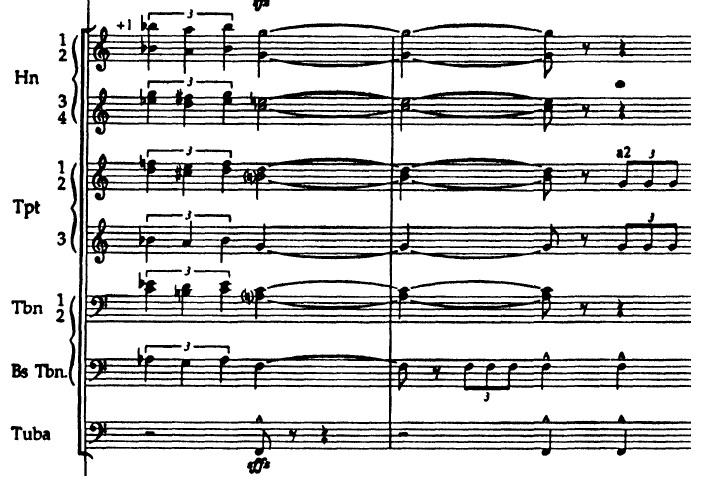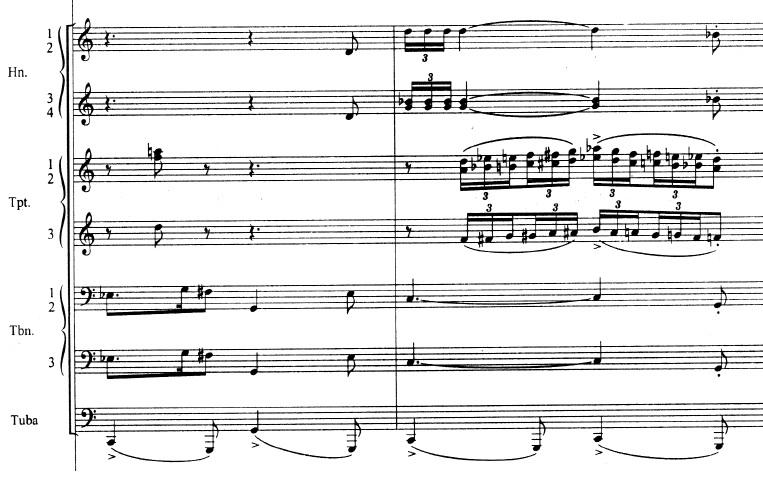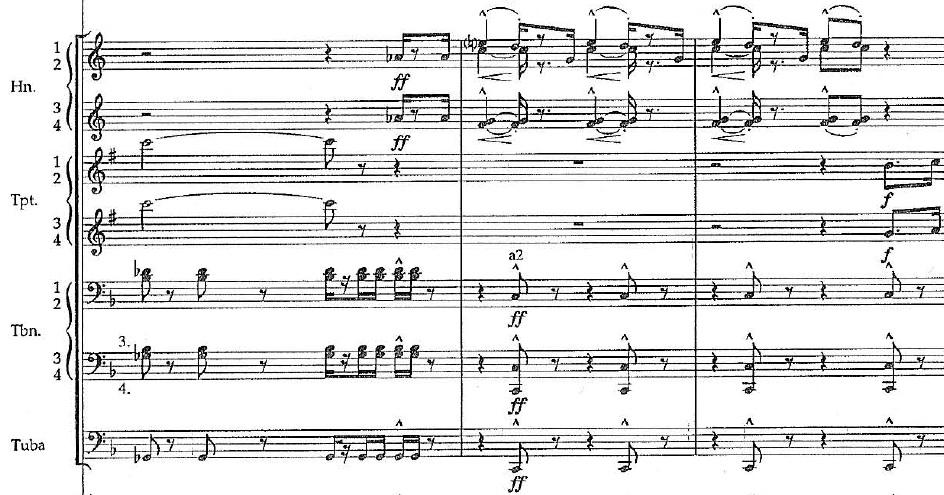
ComposerMITA
Members-
Posts
15 -
Joined
-
Last visited
-
Days Won
1
ComposerMITA last won the day on December 3 2018
ComposerMITA had the most liked content!
About ComposerMITA

Profile Information
-
Gender
Male
Recent Profile Visitors
The recent visitors block is disabled and is not being shown to other users.
ComposerMITA's Achievements
-
Escape from Robot City
ComposerMITA replied to ComposerMITA's topic in Orchestral and Large Ensemble
I'm not relying on the mixing engineer, this piece is simply not necessarily for the concert hall as i said. It's simple as that. I guess you not really familiar with how some film soundtracks are produced nowadays. There are many techniques like overlaying brass, using hybrid elements like samples, lots of different stuff. Trailer music is a good example for music not to be played in a concert hall etc. there are lots of effects, BOOM BOOM etc. it's simply a mix of an orchestra and engineering work basically. I won't elaborate further because i think i already made my point. "Write it as if the orchestra is playing live" can be a good advice, but not really in this situation, because you make it sound like the whole piece is "reyling on the mixing engineeer" which is clearly not the case. -
Escape from Robot City
ComposerMITA replied to ComposerMITA's topic in Orchestral and Large Ensemble
Thanks for your comment! : ) To be honest i would treat this piece as a movie soundtrack meaning not necessariliy to be performed in a concert hall setting etc. and the orchestration choices i made reflect this i think. For example i would a hard time imagine (but correct me if i'm wrong) that the strings could play those repeating notes IN TEMPO for long minutes straight as i marked in the score. Maybe they could and this would be nice, but i'm really not sure. I would assume maybe they could hold the power and intensity as i marked in the first few pages than they became tired eventually and when an even higher intensity needed for the second comback of the theme at M. 154 (and after) they would fail. But anyhow even if they could play it with the intensity needed through the whole piece I would not risk it, if this was for a real movie i would record those tricky sections separetly for the strings having enough takes until they get it right, let them rest between sessions etc. and just mix in this part with the other sections in the end or just using samples and go for a hybrid mix like many film productions do nowadays for the same reasons (pizzicato lines are usually replaced by samples etc. in the same manner in order to keep the intensity of the string lines but also have the pizz lines stick out). About the beginning of the piece your concerns are absolutely valid. I'm a former horn player too (i played f. horn for 10 years in the local wind band), and i know i would fail playing the beginning of my own piece haha. Notes would be so glitchy, but i would assume a professional horn player could play those legato lines even they are tricky with enough practise (to be frank the whole piece is not an easy one and it's quite challanging at some parts). I tried various orchestrations for the brass and the beginning, and this seemed like a good blend with the other sections, so i kept it. Now of course the piano part is very important at the beginning, and this is why i say this piece is not necessarily for the concert hall. In a soundtrack you can have the intensity of the orchestra but also you can emphasize the piano (or other instruments normally wouldn't be heard) to stick out. I like this sound and was tweaking a lot with the dynamics in Reaper until i got it the way i wanted. About the section at M. 132 I wanted to emphasize the wind runs (+ Xylo) and the strings, and wanted the accompaniment to stay in the back a bit. So the timpani hits more like giving a bit more power to the Contrabass + Celli but not wanted to overpower with the bass part too much. The ending is not results in a great crescendo, it fades away with the E minor chord representing the hopelessness maybe the hero feel after realizing they only made the first step for their escape. This project was anyway for Lesson 10 for MITA (music interval theory academy) i'm learning composition now (that's why its in my name also), and it's one of the recommendations for members to write a little story along with the pieces (or before it), that way one can more easily indentify the important emotional points and choose scales/modes and plan the whole piece accordingly. Of course it's not necessary it's just a nice teqnique one can use (even if you not write the storyline on the score at least it gives a good starting point). I can recommend MITA to all of you btw, i learned so many things it's such a wonderful system and there are lots of free lessons and stuff. If you are interested in a more "traditional" orchestration you can take a look at my other piece i uploaded a few months ago "Overture no. 1" (shameless plug lol). 😄 -
Escape from Robot City
ComposerMITA replied to ComposerMITA's topic in Orchestral and Large Ensemble
I marked divisi at the very beginning i don't have to mark it on every other page at least i don't see the point (same with dynamics if its stays the same for longer periods). There's no double stops in the entire piece. -
Escape from Robot City
ComposerMITA replied to ComposerMITA's topic in Orchestral and Large Ensemble
Hey @maestrowick thanks for taking the time to comment! To be honest i'm not really agreeing on most of your points, but at least you took the time to go through the score which i really appreciate! To adress your points in order: According to whom? Please elaborate. Divisi already implied i no need to write it explicitly at bar 39. But just to be clear its not a double stop. Now your assumption maybe that i intentionally wrote bass clef to the viola, maybe that's why you seem to be obsessed over that point lol. I can assure you it's a notation mistake on my part. Usually i change the alto clef to bass clef when i'm writing for viola since i'm better at reading that clef because of my piano background, sometimes i forget to change back in the final score. So again, calm down please haha (good catch though). Now i was hesitating a lot on this one actually. I started to notate that part with fast 16ths and write out every note first, but Sibelius decided to stretch the bars to some very unnatural ways and i wanted to keep those 4-5 bars together in every page. I tried to turn the notehads into smaller ones but wasn't satisfied. In the end i decided to just write the chords and write it to "arpeggio ad lib.", i think most people would get the idea what implied here, also in a real life situation i would notate everything out for the harp player. Well i take it as a reccomendation, but seriously on most film scores at least the bassoon not doing some weird runs or similar. I agree that it's a very nice instrument capable of much more than just doubling the Tuba or bass parts, but in this score i choose to play a secondary role. Now maybe this was the point i was really confused about. What do you mean by that seriously? 😄 Maybe look at a few score examples i uploaded. This was a good point, another scoring error. That happens when you have to write 45 pages of orchestral music, there's always some error that remaining in the final score, i usually listen to every day and follow along with it to find more mistakes but sometime trivial things like that not catching my attention (even after 50 versions lol). Good catch again! Again while we disagree on most points, i always appreciate if someone takes time to help to improve a score! -
Escape from Robot City
ComposerMITA replied to ComposerMITA's topic in Orchestral and Large Ensemble
Well i just looked back at my files, and it took approx 1 month to write a quite basic orchestral sketch. That was like version 1 (V1). It took another 3 month to finish the orchestration (V50) + export all the audio files from Sibelius played by Note Performer to load into Reaper, and tweak the dynamics and everything until i'm kinda satistfied + preparing the final score. Of course Note Performer makes everything easier, but still the afterwork always seem to be much more work, than just simply writing a piece. I can see now why professionals in the industry outsource the orchestration part, the score preparation and mixing parts to different teams/people, it takes like forever for one person. But i like these longer projects one can learn a lot by just writing one of these. -
Hello everyone! I'm Norbert from Hungary and want to share one of my pieces i was working on recently called "Escape from Robot City". https://drive.google.com/drive/folders/1plwbNrJ_LAgKc9oKeu5a0WltstjJyT2A?usp=sharing Soundcloud link: (Now while i added a little backstory to the score as a guide, you can ignore it and rely solely on your imagination what might happen on the screen if it were soundtrack for a real movie) Hope you'll enjoy it!
-
Thank you very much for your comment! I'm glad that my post inspired you to work with live musicians on your own pieces, believe me it's a great fun! Also your remark about measure 113 is perfectly valid! I'm a piano and brass player (f. horn) and i tend to forget how demanding could be to play runs on a wind instrument for example. If i think about it the guy playing the wind parts were actually struggling on that part, there were lots of breathing noises on the original recording he sent, and i was a bit unsatisfied at first, but now that i'm thinking about it i didn't let the guy rest at all for like 9-10 bars. Sure one can breath between the up and down runs, but your idea about dove-tailing that part makes sense. Even Williams let players enough rest between runs when he uses the winds that way (for example in the Indiana Jones score). So good point! Now about the score i was working on that a lot (I still find mistakes every day though). I was inspired by the look of Hal Leonard scores of Williams' music, also I contacted Dynamedion a music company for hiring an orchestra. Now i'm quickly realized that I'm not even close to afford hiring them, but the guy was nice and he sent me the Orchestration Guidelines they use when they work with composers. That includes font sizes, layout sizes, how many bar numbers per page should be used, etc. So i combined that knowledge with what i saw on famous scores and i prepared a little guide and sample score that you guys can use also: DYNAMEDION GUIDELINES + DYNAMEDION.SIB + MY GUIDE HOW TO SET SIBELIUS TO MAKE SOMETHING SIMILAR TO MY SCORE: https://drive.google.com/open?id=1vCC362_zP3tzq2H_Chcf4GTSZhJCxJ5H The part numbers were a matter of adding an "expression text" on the bar and positioning them before the bar. It's a bit tricky though because i tried to maintain a constant distance between the part numbers and the bar, but quickly realized Sibelius messes up the distances pretty quickly (for example the distances are different if you add notes to the score or if the score is empty, or even just adding a time signatures messes up everything) so i precisely measured the distances after every page. It took some time, but i tried to make it look great. If something is not clear from the guide or you have any questions please ask! (also feel free to change everything on the score and use this sample sib file on your own scores)
-
Neo Kinnunen-Ivanovic started following ComposerMITA
-
Thank you very much! I used several orchestration techniques from famous film scores (especially Williams' ones from Star Wars, E. T, and i think the Jaw reference is pretty clear before the last section : )) so i'm glad you felt the pieces like a film score in some places! And yeah putting together the recording was a big challange! I'm planning to do a better one, but now i'm working on other pieces too that hopefully i can present soon.
-
Thank you for your kind words, really appreciate your feedback! : )
-
ComposerMITA started following OVERTURE no. 1
-
Hello everyone! I'm Norbert from Hungary and want to share one of my pieces with you i've written 5 years ago. I included a little backstory for this piece about how i made a little "Fiverr Orchestra" to play my piece which i mixed in with Note Performer 3's samples. Please read it before making any comment, because context matters! Thanks for listening! Enjoy! : ) (I also included the original midi files, along with the recorded live files and also of course the final mix with score. Also i'm not promoting Fiverr in any way as i stated in the pdf, i just wanted to give credits to the musicians involved, because they deserve it!) Here's the link for the midi version: https://drive.google.com/open?id=1CaRCS_8gdb49YOsqAAbKMmhM5eFNbEUC
-
DrTre started following ComposerMITA
-
Hi Gustav just listened to your piece! I'm not really into atonal sounding pieces (except if it used as an effect) so i will not comment on the piece itself. I just want to react to what you wrote in the description to clarify the method i described before: Yeah that's true, however while the aim with this method that every line on one hand should be independent and should stand on its own as good as possible on the other hand it should sound good together also (one should be able to synchronize their vertical and horizontal writing and balance them). Your free lines are your horizontal lines but the resulting chords are your vertical structure and one should keep attention to this also how you leading voices or how your chord progression sounds. It's not an easy task i know i try to learn this as well, just wanted to point out that if you were to aim for a atonal sound that's perfectly fine, but one can write 'diatonic sounding pieces' with this technique also or write in any style really. So don't think about it as mixing modes randomly to generate random results. One can pick scales that are close to each other also, point is to have a logic in your mind and aim and to learn not only to start writing music by writing block chords first (vertical structure), but one can start with free lines (melody and countermelodies, free lines etc- your horizontal structure) as well. If one are able to balance these two really good results can be achieved.
-
Nice! Please share what you would came up with! I would like to listen to it! : )
-
Well you are right that the piece is not entirely modal! Occasionally there are some notes that not part of the given mode or scale : ) Ok i'll try to give a little bit of context here, because your confusion is actually perfectly valid: You can see in my name the word "MITA" that stands for "Music Interval Theory Academy" which teaches a system similar to Spud Murphy's EIS (Equal Interval System) method. (First of all I want to make clear that I DO NOT COME HERE TO ADVERTISE ANY ORGANIZATION OR SYSTEM! I am just trying to give a little bit of context how this piece came to be! So I hope this post and thread will not banned to infinity by the mods just because i mentioned this) The point is both systems have a kind of intervallic aproach to music composition meaning they focus more on the distance between different notes and intervallic formulas instead of thinking in strict tonal centers and scale degrees while also teaching a mindset and giving tools that actually generate music. There are some free courses online you can check it out if you interested and also some YT videos explaining the basics... ---------------------------------------- Now more about the guidelines: So this was originally an assignment about Combining Modes using a set of rules. It goes like this: 1. First write the melody for the soprano part from bar 1 to 16 (line writing) paying attention to choose every second bar a new tonal center and a new mode! 2. Next write a counter melody in the tenor part (without thinking in vertically or in chord structures (!) only horizontally!) doing the same as the soprano choosing every two bar a new tonal center and mode (different from the soprano part)! 3. Now write the alto part using the same modes/tonic as the soprano 4. Do the same with the bass using the same modes/tonic as the tenor 5. Profit (???) ---------------------------------------- Now how i applied the concepts? 1. First i came up with a LOGIC how i will choose my tonal centers and scales: 1a. Tonal centers: - In the Soprano/Alto: Mostly following the Circle of Fifth (It's called a Root Cycle 5 in MITA or just RC5) except the last two bars: D - A - E - B - F# - C# - Ab - D(!) - A(!) - In the Tenor/Bass: It's more complicated, but basically its a combination of different RCs (there are more than just your basic Circle of Fifth - actually there are 6 different RCs in an octave that you can combine freely) 1b. Modes: Random (but paying attention to always choose one not used before and use only scales with 7 notes) 2. Second i wrote the melody first in the soprano paying attention to all the mode changes, then wrote all the other parts afterwards Now here comes the source of your confusion basically (at least what i assume): - The melody is not your usual 8 bar period with two half periods, so it seems like it doesn't have a structure (even though it literally has) - The scale/mode changing picked randomly which result in not the smoothest transitions possible (if someone wants to achieve that one can choose neighbouring scales that's close together only differing in 1 scale tone at once - like Ionian/Lydian etc.) - Third source of confusion come from that on top of that i added some out of scale notes sparingly (that adds to the more cromatic/chaotic feeling to it, which is a nice technique to hide or mask your original ideas/scales, but also it can confuse the hell out of people in some cases i guess) - Also in the final score I rearranged the the whole score to more fit to the tempo changes i applied to them in my DAW (because originally i felt some notes should held longer in the melody, or should be quicker, I marked these places with fermatas) This results in what you mentioned that at the same bar there is a C# and a C which originally occured in two different bars. All in all i can easily understand why you felt confused, and thanks for your clarification also! See the attached original sketch i made the final score from posted above, maybe it can clear up some things. (Also I'm still learning to use this technique btw, this was my first attempt, never wrote polytonal/polymodal pieces before, but this can be a very powerful tool to came up with interesting new musical ideas for writing freely while applying logic and rules at the same time that guide you in the process) I know it sounds confusing so, if someone has a question just ask!
-
This piece is based on the simple logic of switching both tonic centers and scales every two bars with the twist of the soprano/alto and tenor/bass always using different scales/tonic. So it's both polytonal and polymodal at the same time. (The scales were picked randomly, but that was the challange part of it) But why was it hard for you to follow it? Please elaborate.
-
A short experimental composition excercise using various modalities.





